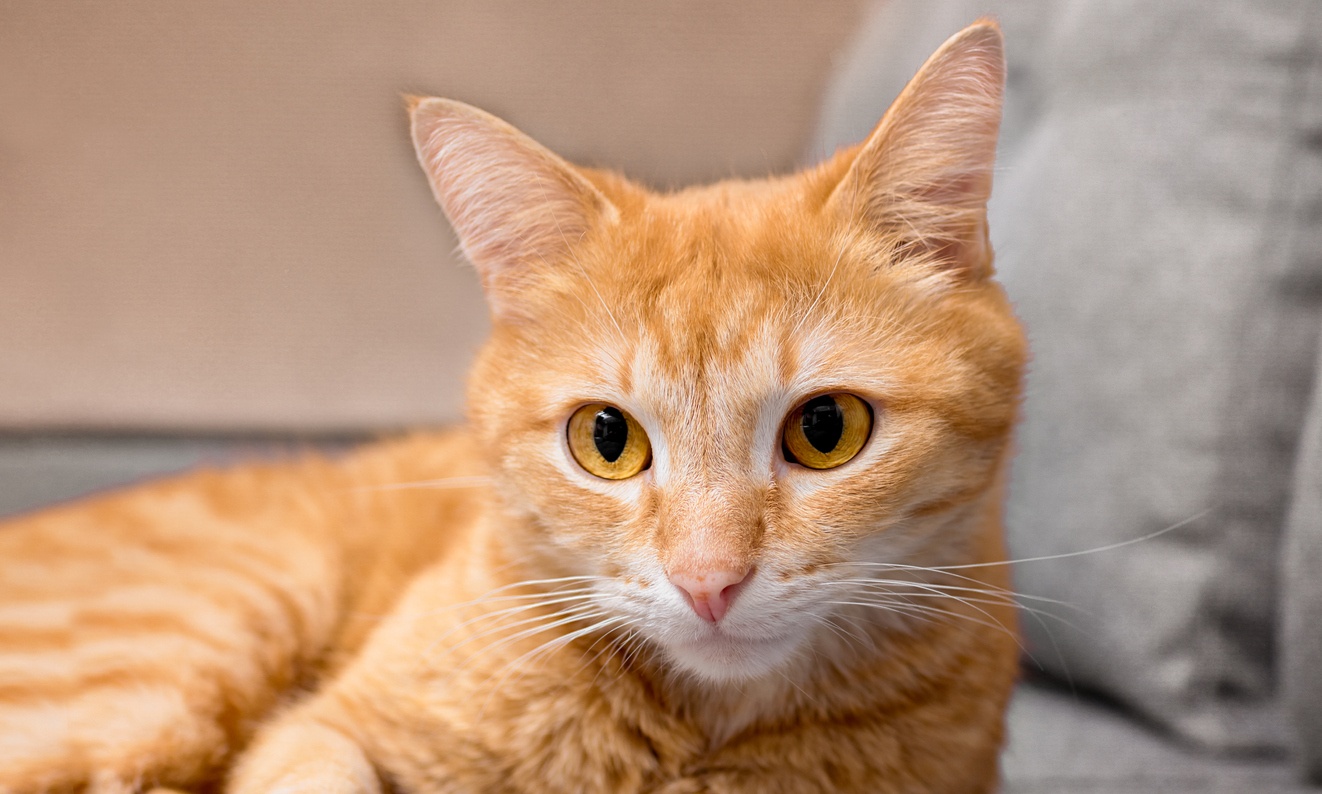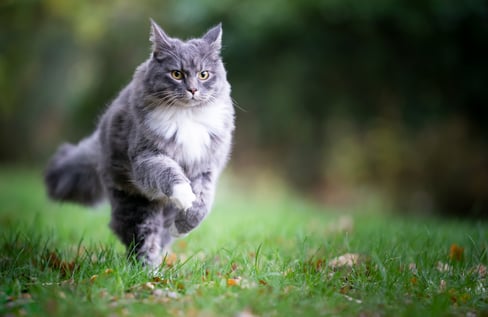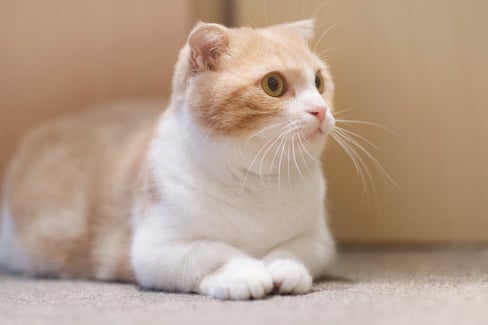Table of Contents
It’s a typical morning. Your cat is walking around proudly, tail up in the air, acting like the king (or queen) of their castle. Everything’s as it should be until suddenly you hear a crash, scuffle, then the telltale sound that your precious kitty has likely injured themselves—a loud, crying-out meow.
You rush to the scene to find your cat looking alarmed but otherwise visibly fine. At this point, it might be difficult to tell if your cat is in pain, as they’ll likely try to avoid you as much as possible, making it tough to examine them closely.
Given the fact that cat personalities range the full spectrum, your particular cat may also act like everything is fine after a potential injury, making it hard for you to tell if your cat is actually in pain or not unless there are clearly visible signs.
In this article, we outline the behaviours, actions, and reactions that you will likely encounter if your cat is in pain. Plus, we provide tips for how to comfort a cat in pain and recommendations for what you give a cat for pain relief.
Signs a Cat Is in Pain
If you suspect that your cat is suffering, you’re probably wondering how to tell if your cat is in pain. Aside from the obvious physical signs, like bleeding or swelling, there are behavioural signs that you can look for.
While every cat has a distinct personality, there are certain behaviours that a typical cat will exhibit if they are in pain. These behaviours include:
- Reduced appetite—your cat may still be willing to eat, just not as much as usual. This could be because of nausea or other stomach issues due to the pain.
- Lethargy—cats typically sleep between 10 to 20 hours a day, depending on their age, regular activity level (jumping and playing around with toys or in the garden is hard work), and overall health. Your sleeping patterns can even affect how much your cat sleeps. But if your cat refuses to move from their resting spot unless they absolutely have to, or is otherwise resting more than usual, it’s time for a trip to the vet.
- Decreased interest—if your cat always goes wild for catnip but suddenly doesn’t care when you give it to them, that’s one way you can tell your cat could be in pain. Not caring about their favourite treats or toys are other telltale signs.
- Hiding and otherwise avoiding you—in the wild, injured animals are more vulnerable to predators and are a liability to the rest of the pack, so they will often hide away until the pain passes so that they can survive by avoiding detection. Your cat’s hardwired instinct to hide is still there, so they will likely do all they can to avoid you while they are in pain.
- Showing increased sensitivity to touch—if your kitty generally loves to be pet and held but suddenly winces or runs away when you try to touch them, it’s one of the signs that your cat is in pain.
- Vocalization, including meowing, hissing, or growling—it’s not unusual for cats to make all kinds of noises to indicate that they are hungry, want to play, or are vying for attention. But when your cat hisses at you, growls, or won’t stop meowing, they might be in pain. It’s important to pay attention to the differences in your cat’s vocalizations.
- Decreased grooming or overgrooming in a certain area—some cats will stop grooming altogether if they are in pain simply because contorting their bodies to reach certain areas worsens the pain. Other times, cats will overgroom a particular area, usually the area that is the source of their pain, in an effort to soothe it.
It’s important to remember that your cat may display one or all of these behaviours, and at different severities. You know your kitty best; if they are acting strangely and the behaviour isn’t improving, they might need a trip to the vet.
Physical Signs Cat is in Pain
Aside from behaviours, you may be able to recognize physical signs your cat is in pain. While physical signs might seem obvious, you may not always recognize them as indications of pain and instead mistake them for something else.
Here are some examples:
- Red, swollen skin—this can be a result of overgrooming or inflammation. If the skin appears thicker than usual and is warm to the touch, it’s likely inflamed. If your kitty has a patch of fur missing and their skin appears red, raw, or rash-like, it could be a sign of overgrooming due to pain.
- Bleeding—it may seem obvious, but sometimes bleeding can be tough to spot, especially if you have a long-haired cat. Look for red or brown stains on their fur (brown indicates that the blood has dried) and investigate the area by gently moving their fur aside to see if you can find the source of the injury.
- Unusual protruding—in some cases, bones or soft tissue can appear to “protrude” from your cat’s body, indicating that there could be a broken bone or injury to muscles, ligaments, or tendons. Your cat will likely respond if the area is touched, indicating that they are in pain, and will likely limp when walking or otherwise avoid putting pressure on the area (such as laying on the opposite side of their body and not moving).
- Limping or holding up a leg when walking—if your cat experiences an injury that impacts their movement, you’ll be able to see changes in their gait (walking pattern) when they move. This could be holding up a leg either permanently or occasionally or not paying attention to a limb when they are moving around, indicating that the limb may not be able to be felt by them due to damage.
- Changes in eye expression—If your cat is staring vacantly at you, squinting, or has permanently enlarged pupils, these are all indicators for how to tell if your cat is in pain. While we usually associate dilated pupils with playfulness, fear, anxiety, and pain are other common reasons your cat could have dilated pupils.
How Do I Know If My Cat Is In Pain?
If your cat is in pain, they will likely exhibit behavioural signs like irritability, meowing more than usual, and hiding or avoiding contact with you. But before you can answer the question of how to tell if your cat is in pain or not, it’s important to understand the difference between signs and symptoms.
- Signs a cat is in pain are indicators that you can perceive—like behavioural changes or visual changes in your cat’s body that you know shouldn’t be there, like bleeding or swelling. We’ve listed some behavioural changes that you can look for in the previous section.
- Cat pain symptoms are a bit different, as symptoms are manifestations of the ailment (in this case, pain) that the cat is experiencing. Since our fluffy felines can’t tell us about their symptoms, we must rely on the signs our kitties show to tell us how they are feeling.
Cats’ faces can also tell us much about their feelings. The feline grimace scale was developed by the University of Montréal in 2019 to give cat owners and veterinarians a useful visual tool for how to tell if a cat is in pain.
The scale involves observing your cat undisturbed when they are awake and not eating, drinking, or vocalizing. Then, it’s simply giving your cat a score, either 0, 1, or 2, depending on the position of their ears, eyes, muzzle, whiskers, and head.
|
Feline Grimace Scale Score |
Meaning |
|
0 (action is absent) |
|
|
1 (action is moderately present or there is uncertainty about its presence) |
|
|
2 (action is very present) |
|
Visually, the feline grimace scale looks like the following:
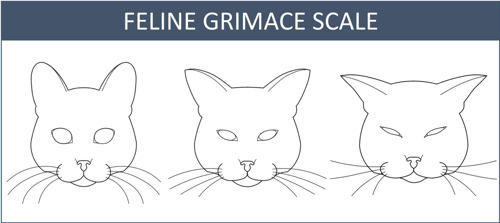
The best way to tell if a cat is in pain or not is to observe their behaviour and facial expressions over a period of time and take notes. Jot down any unusual reactions to your touch, food, or toys so that when you do visit a veterinarian, you’ll have clear information about your kitty to give them. If there are no obvious physical signs a cat is in pain, then your vet will need to rely partly on what you tell them to determine the next steps.
How to Comfort a Cat in Pain
When your cat is in pain, you naturally want to provide them with some sort of comfort. Sometimes, the best thing to do is to provide multiple comfortable places for them to relax until they heal. And give them space. Since cats naturally want to hide away when they are sick or injured, your kitty may not be interested in spending time with you while they are recovering.
There are also small changes you can make to your home to help your kitty get along better while they are healing:
- Keep food and water within easy reach where your kitty has decided to lie. This will make it easier for your kitty to eat and stay hydrated.
- Ensure that their litter box(s) are in an easily accessible place, preferably close to where they are. You may not want to move their original box since they know where it is but provide an additional litter box closer to them.
- Invest in pet stairs or ramps to make it easier for your kitty to get on your bed or couch. These are especially useful if your cat suffers from cat arthritis or a joint injury.
- If you have hardwood, linoleum, or other non-carpeted floorings, place additional mats or rugs in key areas of your home to make it easier for your cat to walk. It can be tough for your cat to get a comfortable grip on slippery floors at the best of times, let alone when they are injured or in pain.
- Minimize noise and activity around your cat. Loud music and noise from other pets or children can cause anxiety and fear in your kitty, especially if their mood is already a bit sour because they are in pain. If you have the space, consider converting a room in your home to a temporary sanctuary for your kitty or setting up a temporary pet pen in a quiet area with everything they need.
What Can You Give a Cat for Pain Relief
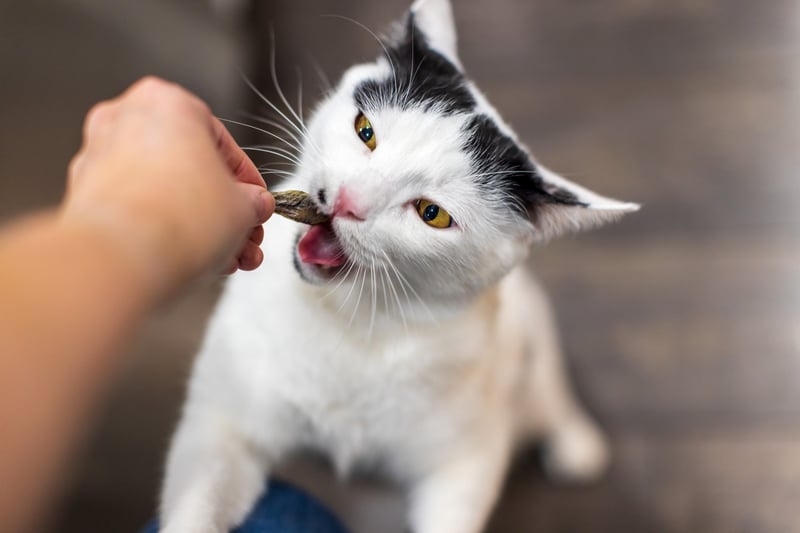
If your cat is injured or recovering from a procedure like spaying or neutering, you may be asking yourself, “What can I give my cat for pain relief?”
Veterinarians will usually prescribe non-steroidal anti-inflammatory drugs (NSAIDs) that are specially formulated for cats to provide them with pain relief. However, NSAIDs can have negative side effects, so it’s important to use them exactly as your vet prescribes.
Side Effects of Cat Pain Medication
NSAIDs have been developed to control fever, swelling, headaches, and other inflammatory responses to pain in animals like cats. At a high level, NSAIDs work by influencing the production of certain substances in the body, specifically prostaglandins, that affect inflammation and pain in the body.
While NSAIDs formulated for cats effectively manage their pain, they can come with some undesirable side effects, especially if they are taken for a long time. These side effects include:
- Vomiting
- Diarrhea
- Lack of appetite
- Lethargy
- Ulcers in the stomach and intestine
It’s important to remember that not all cats will experience these issues, and some may present with minor symptoms initially until their bodies get used to the medication.
What Can I Give My Cat for Pain at Home
Human medications can be expensive, so it’s no surprise that cat pain medication can also be tough on the bank account. This leads to people asking questions like the following:
Can I give my cat aspirin for pain relief?
The truth is that, yes, you can give aspirin to your cat, but that comes with a huge asterisk. Aspirin may be the only ingredient in a medication (good) or part of a product containing other medications like caffeine, acetaminophen, opioids, antihistamines, and decongestants (bad). These additional ingredients can have negative effects on your cat. Acetaminophen, in particular, is toxic to cats.
Even if the aspirin you want to give your kitty doesn’t contain all of that stuff, there is still a risk of aspirin poisoning. This is because aspirin is one compound in a group of chemicals called salicylates. If your cat ingests a large amount of salicylates, it is toxic to their bodies and results in gastrointestinal irritation like bleeding in the gut and ulcers. Cats will often not show signs of poisoning immediately, but signs of internal bleeding include dark, tarry stools, pale gums, and general weakness.
A veterinarian may suggest giving your kitty aspirin, but you have to follow their directions to the letter to ensure that your cat takes the medication safely.
What can you give a cat for pain over the counter?
Unfortunately, there are no NSAIDs that you can give your kitty over the counter safely without asking a veterinarian first. There are only a couple of FDA-approved NSAIDs that are safe to give your cat, and both must be obtained by a veterinarian's prescription. These painkillers are also the only ones offered for cats in Canada.
|
Active Ingredient |
Brand and Generic Names |
How it’s Administered |
|
Metacam® Loxicom®, OroCAM®, Rheumocam, Mobic®, Mobicox® |
Oral liquid, injection, or oral spray (spray not available in Canada) |
|
|
Onsior® |
Injection or oral tablet |
However, if your kitty is suffering from joint pain, you can give them a cat joint supplement like TRI-ACTA H.A. This supplement in particular is completely safe to give your kitty because it contains ingredients that naturally occur in your cat’s body, but at therapeutic amounts to help relieve the pain that comes with achy joints.
TRI-ACTA H.A. for Pets
Our maximum strength formula is optimally designed to accelerate the formation of cartilage, minimize inflammation, expedite the healing process, and improve joint conditions.

What Can I Give a Cat for Pain Aside from NSAIDs
If your cat has chronic cat joint pain or is a senior cat, you may be wondering if there are alternatives aside from NSAIDs for what can you give a cat for pain to prevent these issues from occurring.
Thankfully, there are a couple of options:
- Giving your cat supplements. Feeding supplements can greatly benefit overall cat health, including strengthening their immune system, maintaining digestive health, helping with their skin and coat, and protecting their joints. A joint supplement like TRI-ACTA H.A. is a great option for kitties that experience chronic joint pain or are recovering from a joint injury or surgery. The combination of glucosamine, chondroitin, MSM (a natural painkiller), and hyaluronic acid provides joint protection and pain relief to help your kitty regain their regular self. TRI-ACTA H.A. can also be used in conjunction with NSAIDs to reduce the dosage of painkillers that your cat needs to take.
- Investing in alternative treatments. Like humans, cats can get physical therapy, hydrotherapy (placing your cat into a shallow pool with a treadmill to support their joints as they walk or swim), massage, acupuncture, laser therapy (using light pulses to encourage healing), and more to help treat their pain. These alternative therapies are sometimes used in conjunction with NSAIDs, just like joint supplements, to reduce the dosage of NSAIDs.
How Integricare Can Help With Joint Pain in Cats
When it comes to joint supplements for cats, there are a few important things that make Integricare’s TRI-ACTA products stand out from other options.
- TRI-ACTA products use two different types of glucosamine, sulfate, and hydrochloride (HCL). Each form provides unique benefits for your cat. For instance, sulfur is an essential component of joint tissue, and including glucosamine sulfate ensures your cat gets that essential component. Glucosamine HCL is more stable and doesn’t require salt for stabilization, which means it could be more bioavailable. By including both forms of glucosamine, TRI-ACTA ensures that your cat gets both advantages.
- Glucosamine for cats, when used in conjunction with chondroitin, which TRI-ACTA products contain, assists with cartilage repair and tissue and muscle development in the joints.
- Hyaluronic acid, which is available in TRI-ACTA H.A., provides additional support for ease of joint movement and mobility by improving the viscosity of the synovial fluid in your cat’s joints.
Another important mention is that TRI-ACTA products are made with 100% active ingredients with no fillers, additives, or preservatives. Because of this, you get the maximum value for your money in each container, and you can feed your pet less supplement per serving. Plus, TRI-ACTA products are approved by Health Canada as a Veterinary Health Product, meaning that the ingredients and manufacturing are the gold standard.
Summary
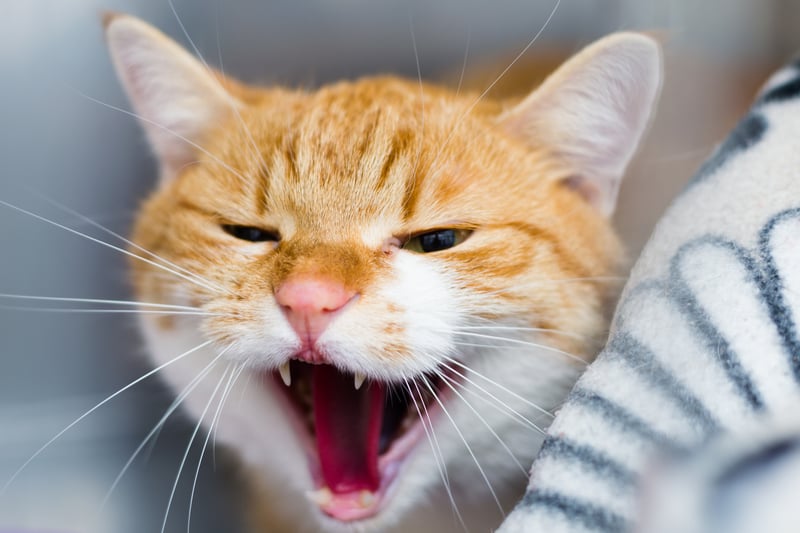
Sometimes it can be difficult to assess the signs a cat is in pain. Paying attention to your specific cat’s behaviours is the first step in how to tell if your cat is in pain or not.
So the next time you’re wondering, “What can you give a cat for pain?” you’ll be armed with the knowledge you need to make educated and effective decisions regarding your cat’s health and well-being.
Joint issues are one common cause of pain in cats. If you suspect that joint issues may be the cause of your cat’s pain, consider getting them started on TRI-ACTA H.A. right away. If your cat is not suffering from joint pain, but you want to be proactive and help protect their joints as they age, then get them started on our regular-strength version, TRI-ACTA.
TRI-ACTA H.A. for Pets
Our maximum strength formula is optimally designed to accelerate the formation of cartilage, minimize inflammation, expedite the healing process, and improve joint conditions.

Newsletter Signup
Subscribe to our newsletter to receive the latest news and exclusive offers.
.jpg?height=2000&name=Cliick_Integricare-DISPLAY-REVISEDV2%20(1).jpg)
Proactive & Therapeutic Joint Supplements
When given daily, Integricare joint supplements recover bone and joint injuries faster and help prevent mobility injuries from happening in the first place.

